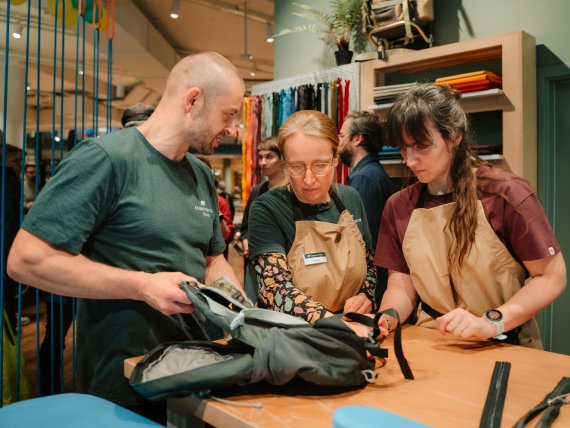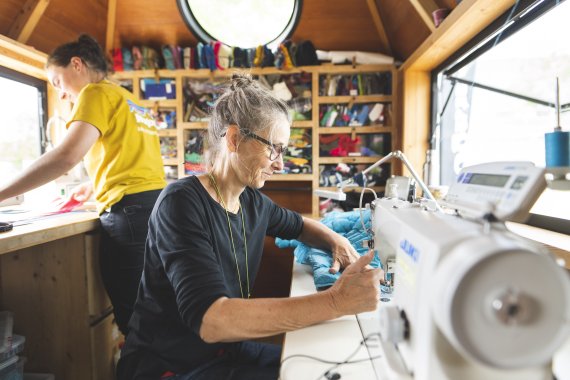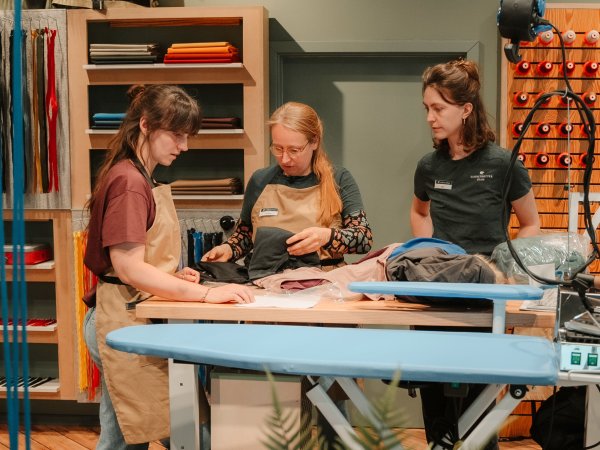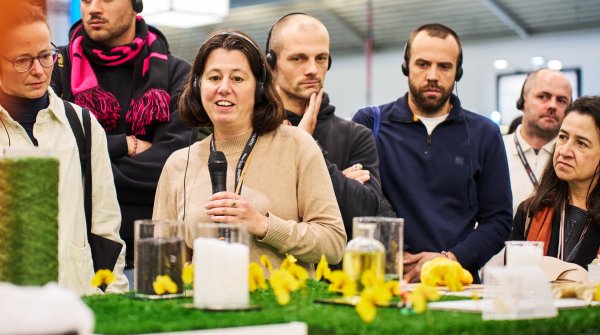Vintage sweatshirts, trail running shorts, shoes, tents, rucksacks... The list of products that visitors to the Worn Wear Tiny House from Patagonia is long. "We've made some people happy here," says Mick Austermühle. Patagonia has been touring Europe with its Worn Wear repairs since 2013, visiting trade shows, events and festivals. "Many people bring us their favorite item, which holds precious memories."

This is how the Patagonia Country Manager Germany & Austria describes the biggest advantage of repair services for brands: customer loyalty. After all, few things are as charged with positive emotions as an item that has accompanied the wearer through countless adventures. A brand that saves the life of this material piece of memory digs deep into the heart of the owner.
It's no wonder that this is also repeatedly taken up in advertising. Thus writes Fjällräven for example, writes about the history of a 43-year-old rucksack, while Deuter has even dedicated an entire campaign to its favorite items under #deuterforever.
Fix it yourself
Even the best cared-for sports and outdoor items wear out after a while and may even break. But the industry thinks ahead. Throwing it away is not an option because your heart is set on your favorite hiking pants, for example? Then it's probably time to lend a hand and repair them yourself. All you need is the right instructions. Where can you find them? You can find repair tips on iFixit.
Intersport has expanded the iFixit range to include instructions for outdoor equipment, clothing and footwear, and there's no huge campaign behind it. Because all it takes is ambitious people with a passion for bringing the spirit of repair to the world.
Mammut has also published figures on its repair service, which the Swiss brand has been offering since 1992. Mammut repairs around 16,000 products worldwide every year. On the one hand in its two repair workshops in Germany and Switzerland, and on the other through an established network of local repair workshops and third-party providers. Replacing zippers is the most common repair. "If you compare the environmental impact of repairing items with buying new products, our workshops save almost 375,000 kg of CO2 and 3,000,000 liters of water every year," says the Mammut sustainability report.
Repairing has long been a trend: in 2009, Martine Postma organized the very first Repair Café in Amsterdam. Repair Café. There are now almost 2,800 branches all over the world, where people come together and repair things that usually no longer have any material value worth mentioning. Growing environmental awareness and increasing sensitivity in the use of resources have supported this development. This is also demonstrated by the more than 100,000 repair instructions that are now available on the ifixit.com platform - everything from a broken microwave to a torn down jacket. Some sports brands, such as Vaude, also provide tutorials there.
The importance of repairs: A case study by Intersport + iFixit at OutDoor by ISPO 2024
Right to repair
The new EU regulations are intended to ensure that manufacturers carry out repairs in a timely and cost-effective manner and inform consumers about their right to repair. The aim is to strengthen the EU repair market and reduce repair costs for customers. Manufacturers must provide spare parts and tools at reasonable prices, and they must not use contractual clauses, hardware or software to make repairs more difficult. Above all, they must not hinder the use of used or 3D-printed spare parts by independent repairers, nor refuse to repair a product solely on economic grounds or because it was previously repaired by someone else.
However, consumers quickly reach their limits when it comes to some repairs, especially for shoes and textiles. Either special tools or materials are required or there is simply a lack of experience. This is why more and more companies are offering post-warranty repairs under different conditions. According to a study by the European Outdoor Group, almost all of the 69 brands surveyed already offer repair services (76%) or plan to offer them (19%). The few brands that were negative about repairs usually justified this with the costs or complicated logistics.
Repair platforms such as Goodloop are now helping to optimize the after-sales service process. Among other things, the interface offers shipping processing, real-time repair status and data analysis on repaired items and the amount of CO2 saved through repairs.
Repair: 5 advantages for brands
- Customer loyalty: Customers who have their garments repaired have an emotional connection to the products and are more likely to buy from the company again.
- Sustainability: Repair services extend the lifespan of products. This reduces resource consumption and environmental impact.
- Differentiation: In the highly competitive sports industry, offering or refusing repair services can be a competitive advantage or disadvantage.
- Additional revenue stream: If a company advertises the service well and builds a good reputation, repair services can generate additional revenue.
- Image and reputation: A company that offers repair services is perceived as quality-conscious, responsible and customer-oriented.

Retailers also use repair offers to retain customers and boost sales - and this even applies to online-only retailers. According to the eCommerce report by creativestyle almost 50 percent of the largest German online stores in the sports and outdoor industry already offer this service.
Globetrotter recently opened its 17th repair workshop in Germany in its Cologne store. According to Matthias Schwartze, this is now "Europe's largest network of inner-city repair workshops". "Last year, we handled, maintained, repaired and put around 25,000 items back into circulation," says the Globetrotter marketing manager, pleased with the positive response from customers.
The repairability and durability of products has increased in recent years, adds Retail Manager André Gerber: "The number of mono-materials is increasing, as are the demands brands place on their suppliers." The procurement of spare parts still sometimes causes problems. "But we are in the process of reorganizing the processes with our brands. Parts must be available in sufficient quantities and this must be managed in production. We are also currently testing a 3D printer that we could use to reproduce individual parts such as buckles."
Repair: 5 advantages for retailers
- Customer loyalty: Customers who can have their defective products repaired feel valued and well looked after. This leads to greater customer loyalty and a positive image for the retailer.
- Increased sales: Paid repair services lead directly to increased sales. In addition, they can influence customers to consciously choose that retailer as they value the convenience and reliability of a repair service.
- Differentiation: In the highly competitive sports industry, offering or refusing to offer repair services can be a competitive advantage or disadvantage.
- Customer traffic and cross-selling: Customers who bring their products in for repair must enter the store or visit the online store and can make further purchases during the repair process. This offers retailers cross-selling opportunities.
- Image and reputation: Retailers who offer repair services are perceived as quality-conscious, responsible and customer-oriented.

The number of repairs is still manageable and relatively easy for brands to handle. However, this will change with greater acceptance and processes will need to be professionalized. Equip Outdoor, with its Rab and Lowe Alpine brands, has therefore already opened four service centers in Canada, the USA, the UK and the Netherlands. The company also offers a "second stitch" there, where only recycled fabrics and offcuts are used for repairs. This saves even more resources and the sometimes contrasting fabrics and trims make the favorite pieces absolutely unique.
Patagonia also repairs clothes not only at trade shows such as OutDoor by ISPO, but since 2022 together with other textile companies at the United Repair Center (URC) in Amsterdam - a project that puts socially disadvantaged people in particular to work. Willem Swager, Director of Finance & Operations EMEA at Patagonia, says: "The textile industry needs a structural change. That's why we are calling for the reuse and longer wear of clothing through repair and recycling. It needs to become the norm for more brands to offer this as a service and consider it part of their normal business." Or, as the URC website puts it: "Repair is the new cool!"
- ISPO awards
- Mountain sports
- Bike
- Design
- Retail
- Fitness
- Health
- ISPO Job Market
- ISPO Munich
- ISPO Shanghai
- Running
- Brands
- Sustainability
- Olympia
- OutDoor
- Promotion
- Sports Business
- ISPO Textrends
- Triathlon
- Water sports
- Winter sports
- eSports
- SportsTech
- OutDoor by ISPO
- Heroes
- Transformation
- Sport Fashion
- Urban Culture
- Challenges of a CEO
- Trade fairs
- Sports
- Find the Balance
- Product reviews
- Newsletter Exclusive Area
- Magazine







